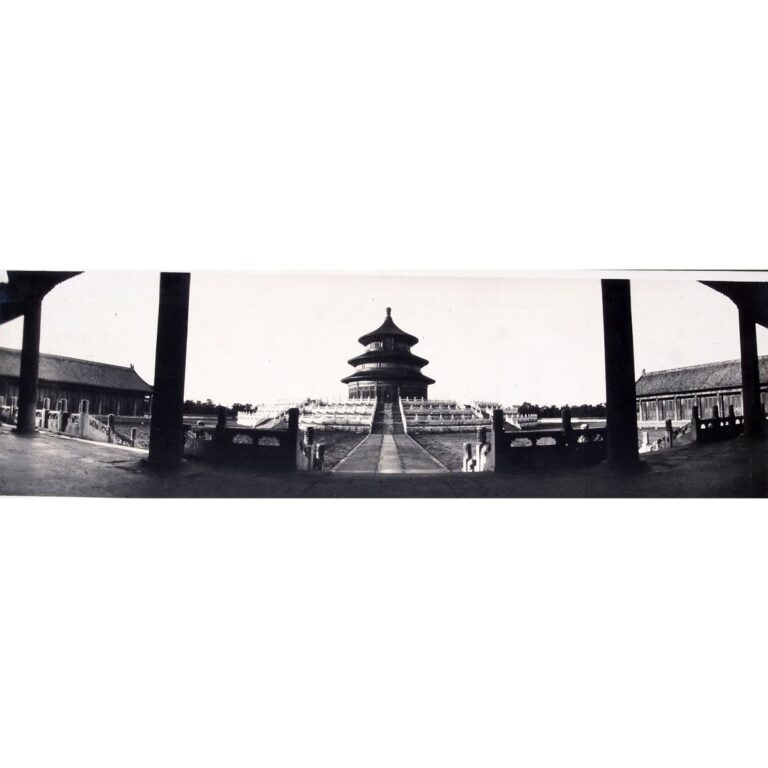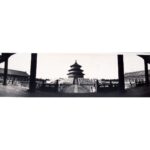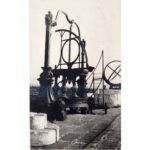Photography Qinian Hall at the Temple of Heaven
A black-and-white photograph, wide-angle view of the Qinian Hall (Qiniandian 祈年殿), which literally means “Hall of Supplications of the Year”, and the central part of the Temple of Heaven complex in Beijing. The complex was built in 1420 by the Yongle Emperor (reigned 1402–1424). Here the emperors of the Ming and Qing dynasties performed the rites of heavenly worship twice a year. In Qinian Hall, on the day of the summer solstice, the emperor made offerings to the heavens and the ancestors, asking them for favour for the coming half year. In literature it is often called “Hall of Prayer for a Good Harvest”. It is the oldest and most famous part of the Temple of Heaven complex. When the Yongle Emperor built the original complex, it included only the area around the Qinian Hall and its associated infrastructure. In the 16th century, additional infrastructure was built in the southern part, including the Yuanqiu Offering Platform (Yuanqiutan 圜丘壇), which ... more
A black-and-white photograph, wide-angle view of the Qinian Hall (Qiniandian 祈年殿), which literally means “Hall of Supplications of the Year”, and the central part of the Temple of Heaven complex in Beijing. The complex was built in 1420 by the Yongle Emperor (reigned 1402–1424). Here the emperors of the Ming and Qing dynasties performed the rites of heavenly worship twice a year. In Qinian Hall, on the day of the summer solstice, the emperor made offerings to the heavens and the ancestors, asking them for favour for the coming half year. In literature it is often called “Hall of Prayer for a Good Harvest”. It is the oldest and most famous part of the Temple of Heaven complex. When the Yongle Emperor built the original complex, it included only the area around the Qinian Hall and its associated infrastructure. In the 16th century, additional infrastructure was built in the southern part, including the Yuanqiu Offering Platform (Yuanqiutan 圜丘壇), which later became the main venue for the winter ritual.
The Qinian Hall is a circular building 38 metres high. It stands on a 6-metre-high square platform with a balustrade. The number of platform levels and the number of balustrade columns are multiples of 9 – a number reserved for imperial infrastructure. To the left and right of the Qinian Hall are the western and eastern outbuildings. In between, behind the photographer’s back, is a third building, the Huangqian Imperial Celestial Hall (Huangqiandian 皇乾殿). All buildings are constructed using the traditional Chinese construction technique, the dougong 斗拱 system. In addition to the dowels in the eaves, other interesting construction features in the Qinian Hall are the roof shapes and the use of colours, numbers, and decorative animal figures. For imperial infrastructure, including temples, certain roof shapes and the use of a quatrefoil (wudianding 廡殿頂) were prescribed. Unusually, the temples of the Temple of Heaven and their roofs are round in shape. The exception arises from the “special” function of this complex, namely the worship of the heaven, which in Chinese tradition is symbolised by a circle. This complements the earth, symbolised by a square. Therefore, round temples stand on square platforms. The motif of square and circle as a symbol of harmonious creation is widespread in Chinese culture. It is found not only in architecture, but also in the shapes of coins, chariots and carriages. Another exception is the choice of colour for roof tiles. While yellow was designated by law for exclusive imperial use (yellow tiles are found in the Forbidden City and the Summer Palace in Beijing), the Temple of Heaven is roofed with blue tiles, which also symbolise the sky. Under the dowels, the walls are decorated with blue, yellow and green patterns symbolising the sky god, the emperor and the common people.
The entire area around the Qinian Hall is only a few hectares in size and is part of the 273-hectare Temple of Heaven complex, now located in southeastern Beijing. It consists of a square courtyard surrounded by a wall. The venue can be reached through three entrances that connect the temple with other facilities such as the ritual kitchen in the east, the Changing Terrace, and the Butcher’s Pavilion. The last emperor to bow to heaven at the Temple of Heaven was Yuan Shikai 袁世凱 (reigned 1915–1916), who for several months tried unsuccessfully to revive the monarchy. This marked the end of a centuries-old tradition. Today, the Temple of Heaven is on the UNESCO World Cultural Heritage List, as it is the largest religious complex in the world.
The photograph is the 174th of 449 photographs of Beijing and its surroundings in the album of Ivan Skušek Jr., purchased during his stay in Beijing (1914–1920). In the handwritten inventory of the album, the photograph is referred to as Himmels-Tempel: Haupttempel (Tien-Tan). (DZ, MV)





































Do you have a comment or additional information about the subject?